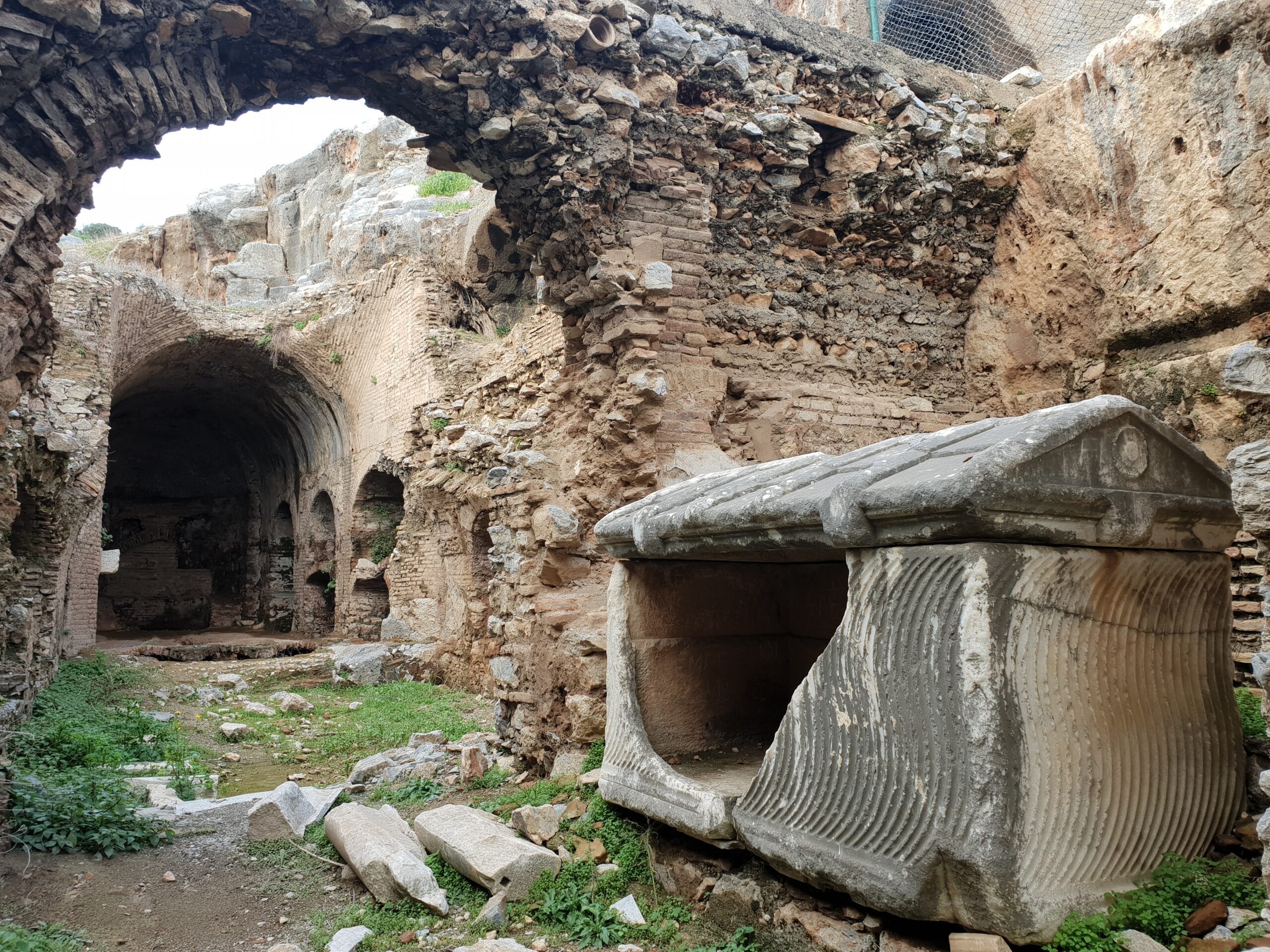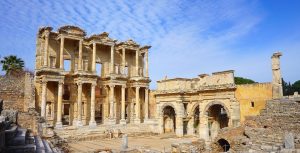Table of Contents
ToggleBurial in Ephesus
Burial methods and rituals of the dead in Ephesus
Although we do not believe that we will die, unfortunately, we will. For this reason, it is enough to look at the ancient city of Ephesus, one of the largest metropolises in history. Ephesus is such a big ancient city that it was one of the world’s four largest ancient cities in the ancient Hellenic period and the ancient Roman period.
So, how were people buried in the great ancient city of Ephesus, and what burial rituals were used? What was done for the Ephesian dead? What stages did the dead go through before they were buried, and what did death mean to the Ephesians?

The Ephesians living in Ephesus believed that they would be resurrected after they died. When a person died, his relatives would wash him with scented water for his last journey and wrap him in white cloths, leaving his face uncovered. The corpse was prepared in this manner and left at the house’s entrance with its feet on the door for a day or two.(Prothesis: exposition of the dead.)
For a while, laments were made for the dead, and relatives of the dead would visit the graves and say goodbye.
Except for his wife, daughter, sister, and mother, who were relatives of the Ephesian dead, women were not allowed near the dead. Lamenters were sometimes found to lament, and they were paid to lament.
Burial in Ephesus
First day of the dead in Ephesus
Prothesis forms the first stage of the funeral ceremony. Prothesis is primarily used to announce and register death.Apart from this, it provides time for the family and relatives gathered around the deceased to show their respect to the deceased, to express their pain, and to prepare the deceased before the burial ceremony.
The prothesis in the early periods in Ephesus was a ceremony attended by a large crowd and performed outside the house of the dead. B.C. We learn from the sources that the prosthesis has been applied inside the funeral home or in the courtyard since the 6th century.
Before the procession began, it was the women’s duty to prepare the dead. The first thing to do is completely close the eyes and mouth of the deceased, and this duty belongs to the parents if the person is married, if not to his spouse.
After that, the dead were washed and oiled. The last stage before the prosthesis starts is the dressing of the dead. His garment was knitted by the lady of the house. The dead, dressed in three layers, were laid on the bed and covered.
Thus, the prothesis would have started with laments from the closest relatives and friends, especially women, pulling their hair and injuring their faces. Tattoo yourself (kopetos). This gesture, known as this, is for the display of pain. Showing pain is important for the deceased’s soul to find peace.
For this reason, the closest relatives of the deceased tried to express their pain by pulling their hair and tearing their faces apart during the procession and ekphora (taking the dead to the place where they will be cremated or buried) in Ephesus.
Second day of the dead in Ephesus
In the following periods, various prohibitions and restrictions were imposed on these rituals due to abrasive acts such as pulling out people’s hair, nailing their faces, beating their breasts during the lamentation at Ephesus, and financial negativities such as exaggeration of expenditures.
After the second day at the latest, the dead were taken to the cemetery (Necropolis), called the city of the dead, with a funeral procession at dusk before sunrise. At the head of the funeral procession in Ephesus, there was a woman carrying a vase, and behind the funeral, there were relatives of the dead.
Touching the dead is a gesture performed by women that is frequently seen in funeral scenes (on tombstones, vases, and dishes). Touching the corpse, which is defined as an expression of closeness with the deceased, was performed by touching the head in some cases and the chest in other cases.
Third day of the dead in Ephesus
On the third day of death and in the early hours of the day, before sunrise, according to some sources, the ceremony of taking the deceased from the house to the necropolis (ekphora) took place. At the beginning of the funeral procession in Ephesus, there was a woman carrying a vase, and behind the funeral there were relatives and relatives of the dead.
We learn from the sources that during the Ekphora, generally simple, four-wheeled trolleys were used. Carts were preferred because of their large crates, which were suitable for placing the sarcophagus or the kline (table) on which the dead person lay.
Burial of the body in the cemetery
The dead were either cremated (cremation) or buried (inhumation) in the cemetery.
In ancient Ephesus, it was believed that flesh and muscles connected the spirit (psykhei) to the world of the living and prevented ghosts from entering. Cremation is a method used to quickly destroy flesh and muscle, thus releasing the spirit. The ashes and bones left over from the cremated corpse were placed in ceramic containers called urns, and this container was buried in the ground with the gifts of the dead. Both the burning process and the necropolises were done in the pits reserved for this work.

In cases where the body integrity of the dead was preserved, tomb types such as sarcophagi, cist graves, pithoi, tile graves, and simple earthen graves could be used. The fact that there are so many different types of tombs in Ephesus, which has more or less the same cultural characteristics and beliefs, is explained by the differences in traditions and economic situation.
For example, the simplicity of the burials found in simple earthen burials (the type of burial in which the corpse is buried directly without any covering) suggests that only poor people could have been buried in such burials.
If an adult Ephesian was to be buried, he was simply buried in a pit dug in the ground, with his head facing east. If the person was rich and had a sarcophagus built for himself while he was alive, the body was buried in this sarcophagus.
We have learned from visual resources, written sources, and research that the cremation method was never applied to the bodies of children and infants in ancient Ephesus. The reason for this is that it is assumed that children and infants are in need of more protection, and it is predicted that child and infant graves will be buried in graves as burials.
In addition, the burial of Ephesians in Pithos is not a culture belonging to the Ephesian period. In Anatolia BC, the practice of burying the dead as a single body in pithos began. It was an ancient culture dating back 3500 years.

The head of Medusa was depicted on the sarcophagi of the Ephesians in order to ensure that the tomb robbers did not damage the sarcophagus, and the names of the deceased Ephesian and his mother were written on the inscription plate called the tabula ansata. In addition, the motif indicating the profession of the deceased Ephesian was depicted on one or both sides of the tabula ansata.
If the deceased was an Ephesian soldier, a shield and a spear would be depicted on the sarcophagus, and if the deceased was an Ephesian theater artist, a theater mask would be depicted on the sarcophagus.
If the Ephesian dead were to be cremated, the corpse was burned by lying on a platform with wood underneath. The ashes and bones left over from the cremation were collected with a cloth and placed in an Ostatek (an ash storage container).
Traditions practiced after death
Funeral games were also held to honor the dead and please his soul. These games are athletics, wrestling, and javelin throwing.
After that, the Ephesians would return to the house of the dead, and the dead owners would wash and eat together. (perideipnon) On the next day, the dead house was thoroughly washed with water.
We also know that the deceased was included in the feast given on the birth date or special day of a deceased Ephesian at festivals, thanks to the offering made with holes or pipes (profusio) through which food and drink could be poured.
The funeral home had been smoking all day.(Sage incense, Lavender incense, Laurel incense, Peppermint incense, Clove incense, Lily incense, Rose incense).Peppermint incense was used. Because mint was used in ancient Ephesus as a favorite fragrance of Hades, the god of the underworld. It was burned with frankincense oil obtained from the tree in incense. This oil was used extensively in churches during the Christian era.

It was thought that the Ephesian Dead would be resurrected, and some of the things he loved and used in his daily life were put in the grave with the dead. Among these items, money, a drink or water bowl, a mirror, jewelry, a comb, a hair pin, and a bracelet can be counted. A silver or gold coin was occasionally placed between the deceased’s teeth.
This money was for the crossing of the river Styks (the river of hell), which must be crossed on the way to the afterlife. Nine days after the burial of the Ephesian dead, the days of mourning were considered to have ended, and his property was shared by his heirs.
It was seen that sometimes curses were written on the tabula ansata so that the graves of the deceased Ephesians would not be opened and robbed. A civil service was established to ensure that many ancient city tombs were not robbed, broken, or used by others; in other words, to protect them.
In ancient Ephesus, death rituals were practiced almost as closely as in our time. Burial techniques are carried out in parallel with those of the ancient world in our time. Incredible discoveries at Ephesus, one of the greatest cities of the ancient world, continue to surprise us even after 2000 years. This wonderful ancient city of Ephesus is waiting for you and Artemis to share its mysteries with you.






